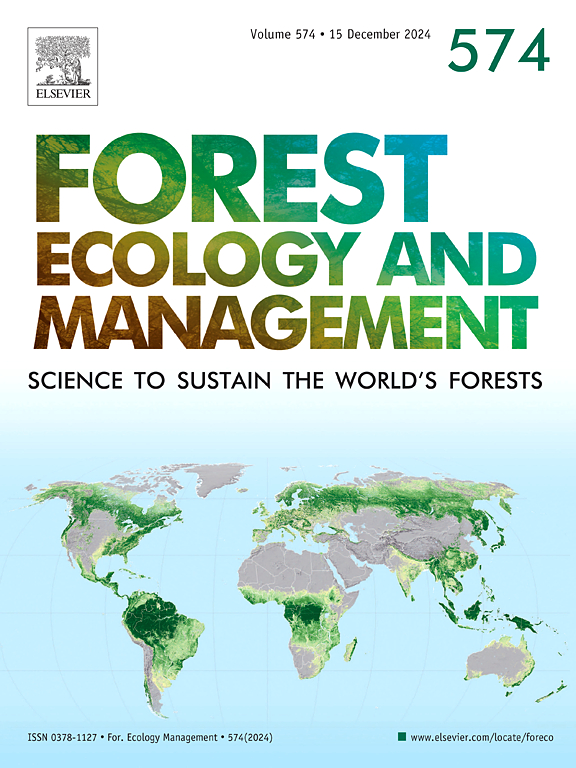Exotic pine plantations vs. native forests in northern Patagonia: Comparing growth patterns and climate change vulnerability
IF 3.7
2区 农林科学
Q1 FORESTRY
引用次数: 0
Abstract
The area planted with exotic conifers has rapidly increased between the 1970s and 2000s in northern Argentinian Patagonia, replacing in many cases native Nothofagus and Austrocedrus forests. Direct comparisons between pine plantations and native forests with respect to growth patterns, productivity and climate vulnerability are lacking so far. Here, we explore differences in radial growth, climate sensitivity of growth and stomatal regulation between planted exotic (Pinus ponderosa, P. contorta, P. radiata) and neighboring even-aged native stands (Austrocedrus chilensis, Nothofagus dombeyi) during the stem-exclusion phase (first 32 years) using dendrochronology and stable isotope analysis of stem wood. While all Pinus stands reached maximum basal area increment (BAI) earlier than the native species, Nothofagus dombeyi was as productive as Pinus radiata, the most productive exotic conifer. The main climatic growth constraints were in all five species rainfall deficits and elevated temperatures in late spring/summer, with the most productive species being more sensitive to climate. Stem wood Δ¹³C and δ18O signatures suggest higher stomatal conductance and transpiration losses of the three exotic Pinus species and a recent transpiration increase compared to the native species with an apparently more conservative water use. Our results show that introduced Pinus species are not necessarily more productive than native tree species, and their growth may be more vulnerable to climate warming. Since all planted Pinus species are invasive in the region and are increasing the fire risk, it is advised in the face of climate change to preferably plant native tree species, where possible, and to reduce the area of conifer plantations.
巴塔哥尼亚北部的外来松树种植园与原生森林:比较生长模式和气候变化脆弱性
20世纪70年代至21世纪初,阿根廷巴塔哥尼亚北部种植外来针叶树的面积迅速增加,在许多情况下取代了当地的Nothofagus和Austrocedrus森林。迄今为止,松树人工林和原生林在生长模式、生产力和气候脆弱性方面缺乏直接比较。本研究利用树木年代学和茎材稳定同位素分析,探讨了外来种植松树(Pinus ponderosa, P. contorta, P. radiata)和邻近的均匀生长的本地林分(Austrocedrus chilensis, Nothofagus dombeyi)在茎排期(前32年)的径向生长、生长的气候敏感性和气孔调节的差异。虽然所有松林均比本地松林更早达到最大基底面积增量(BAI),但东北针叶松的生产力与外源针叶松相当。5种植物生长的主要气候制约因素是降水不足和春夏后期气温升高,产量最高的物种对气候更为敏感。茎材Δ¹³C和Δ 18o特征表明,与本地种相比,3种外来种的气孔导度和蒸腾损失更高,蒸腾最近增加,水分利用明显更保守。研究结果表明,引进的松木物种并不一定比本地树种的生产力更高,它们的生长可能更容易受到气候变暖的影响。由于所有种植的松属物种在该地区都是入侵物种,增加了火灾风险,因此在气候变化的情况下,建议在可能的情况下最好种植本地树种,并减少针叶树人工林的面积。
本文章由计算机程序翻译,如有差异,请以英文原文为准。
求助全文
约1分钟内获得全文
求助全文
来源期刊

Forest Ecology and Management
农林科学-林学
CiteScore
7.50
自引率
10.80%
发文量
665
审稿时长
39 days
期刊介绍:
Forest Ecology and Management publishes scientific articles linking forest ecology with forest management, focusing on the application of biological, ecological and social knowledge to the management and conservation of plantations and natural forests. The scope of the journal includes all forest ecosystems of the world.
A peer-review process ensures the quality and international interest of the manuscripts accepted for publication. The journal encourages communication between scientists in disparate fields who share a common interest in ecology and forest management, bridging the gap between research workers and forest managers.
We encourage submission of papers that will have the strongest interest and value to the Journal''s international readership. Some key features of papers with strong interest include:
1. Clear connections between the ecology and management of forests;
2. Novel ideas or approaches to important challenges in forest ecology and management;
3. Studies that address a population of interest beyond the scale of single research sites, Three key points in the design of forest experiments, Forest Ecology and Management 255 (2008) 2022-2023);
4. Review Articles on timely, important topics. Authors are welcome to contact one of the editors to discuss the suitability of a potential review manuscript.
The Journal encourages proposals for special issues examining important areas of forest ecology and management. Potential guest editors should contact any of the Editors to begin discussions about topics, potential papers, and other details.
 求助内容:
求助内容: 应助结果提醒方式:
应助结果提醒方式:


